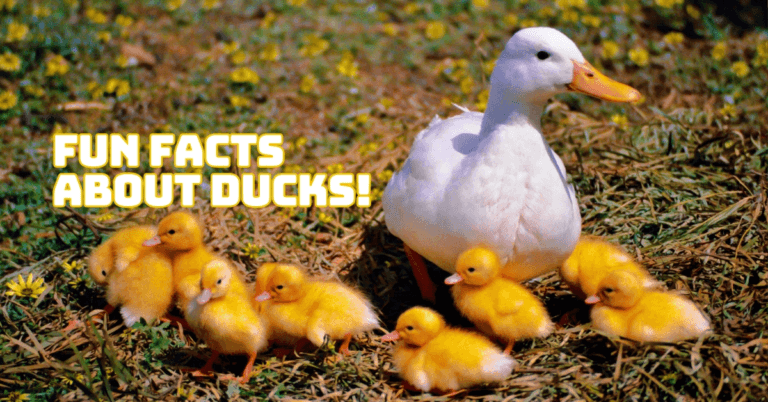Fun Facts About The Northern Cardinal
Fun Facts About The Northern Cardinal
The Northern Cardinal, a vibrant and musical songbird, is a beloved icon in North America. With its striking red plumage, the male cardinal is instantly recognizable, while the female, adorned in warm tones of brown with hints of red, exudes subtle elegance.
Known scientifically as Cardinalis cardinalis, this bird is a year-round resident in the eastern United States, parts of Mexico, and Central America.
Beyond their beauty, cardinals play a significant role in our culture and ecology, bridging the gap between nature and human society.
In this article, we’ll explore their adaptability to urban and suburban environments and showcase their resilience, making them a common yet fascinating subject for bird enthusiasts and casual observers alike.
As we delve into the enchanting world of the Northern Cardinal, prepare to discover intriguing facts about their behaviour, diet, mating rituals, and the unique ways they interact with their environment.
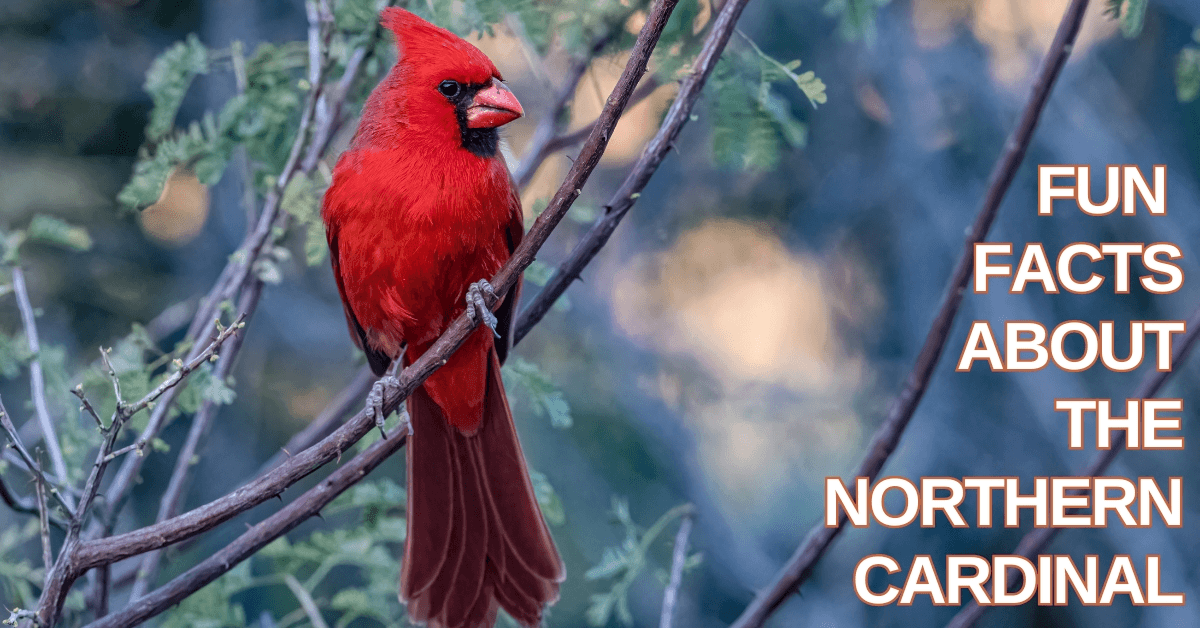
Types Of Cardinals In North America
Cardinals are a well-loved family of birds in North America. Several distinct species enchant bird enthusiasts and nature lovers.
Here are the primary types of cardinals you can find across the continent:
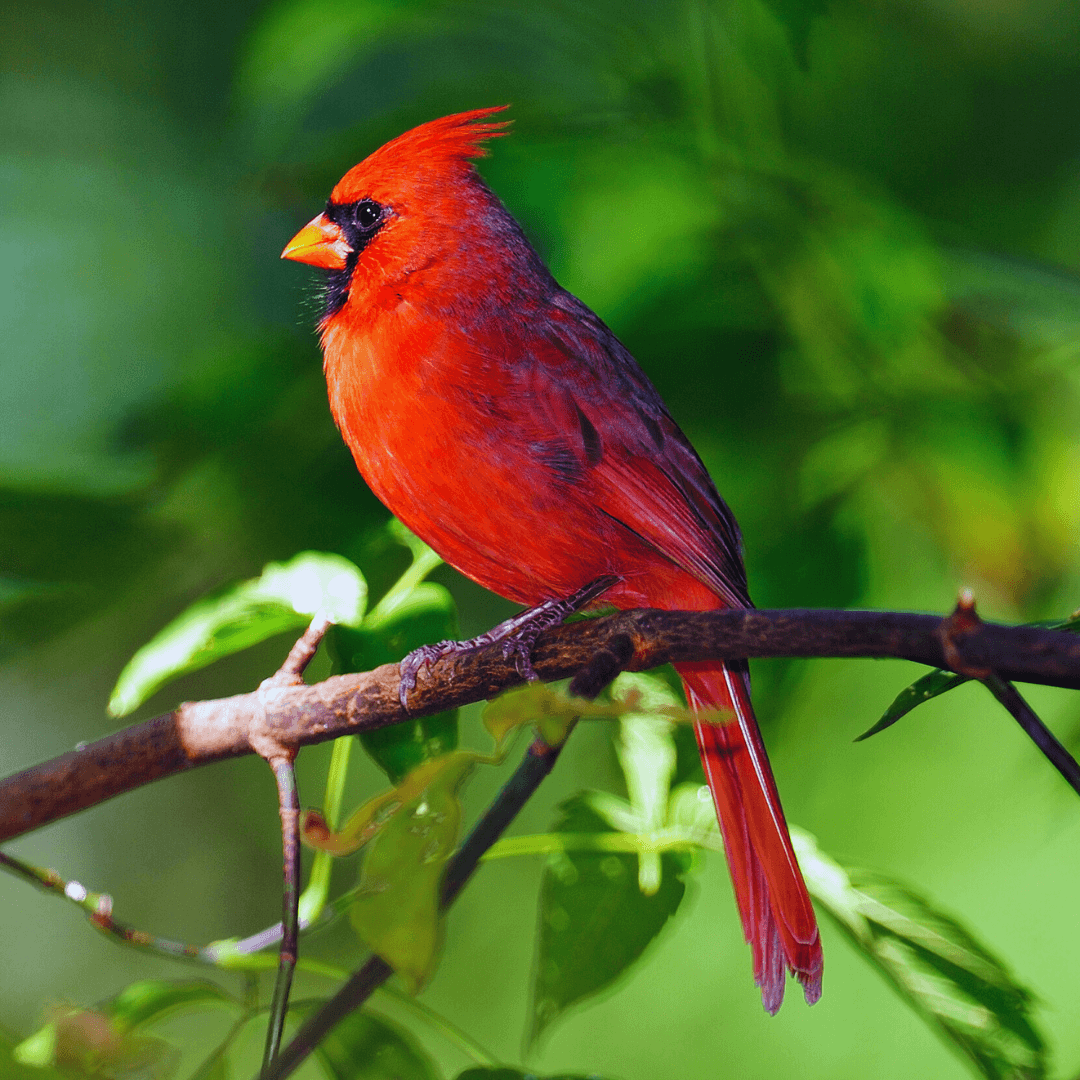
1. Northern Cardinal (Cardinalis cardinalis)
The Northern Cardinal is North America's most iconic and widely recognized cardinal species. Males are known for their brilliant red plumage, while females are a more subdued brown with reddish tinges.
They are found throughout the eastern United States, Mexico, and Central America. Their vibrant colour and melodic songs make them a favorite among birdwatchers.
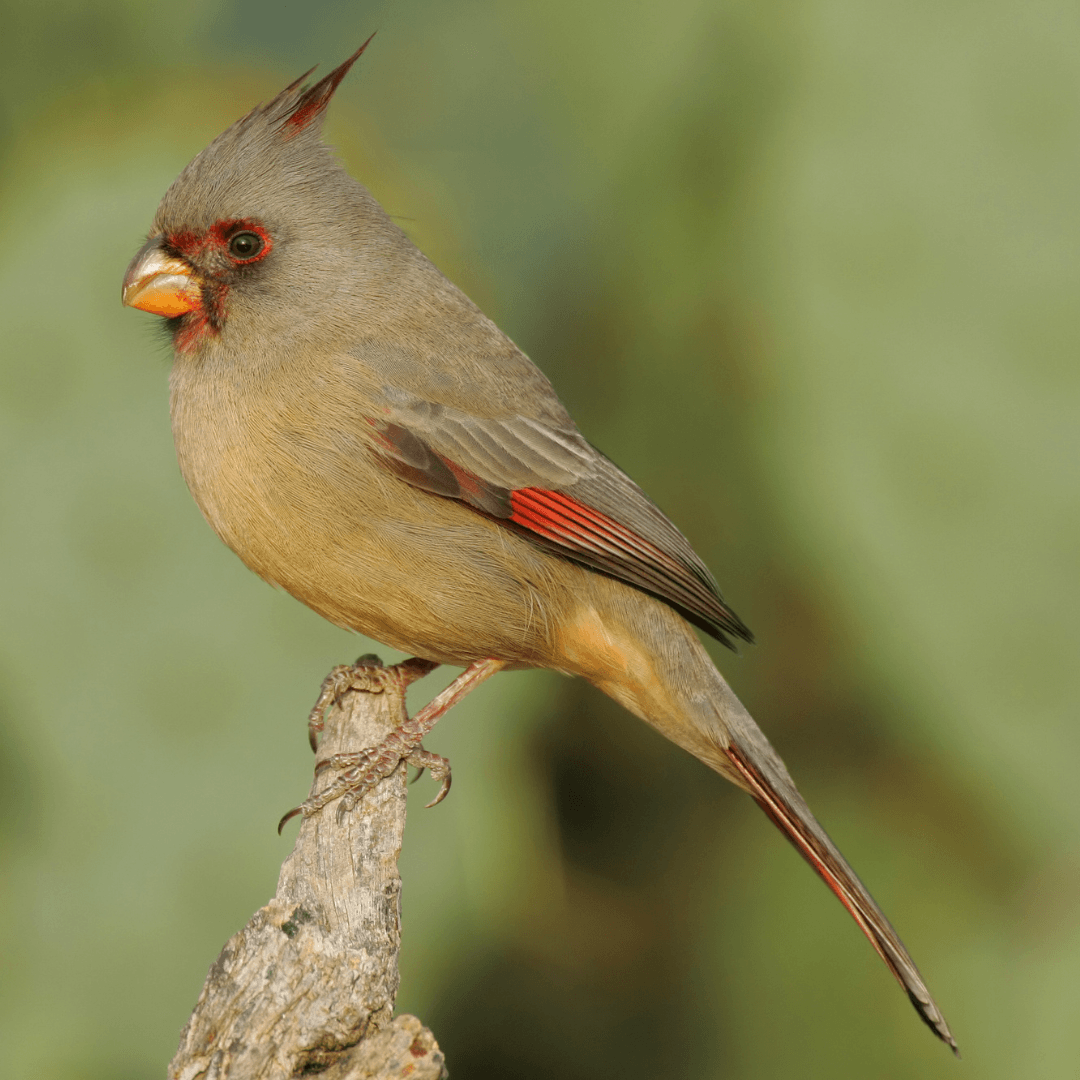
2. Pyrrhuloxia (Cardinalis sinuatus)
Natural to the southwestern United States and northern Mexico, the Pyrrhuloxia is also called the Desert Cardinal.
Males have a striking appearance with a mix of gray and red plumage, while females are mostly gray with touches of red. They thrive in arid desert environments and are recognized by their unique, parrot-like beak.
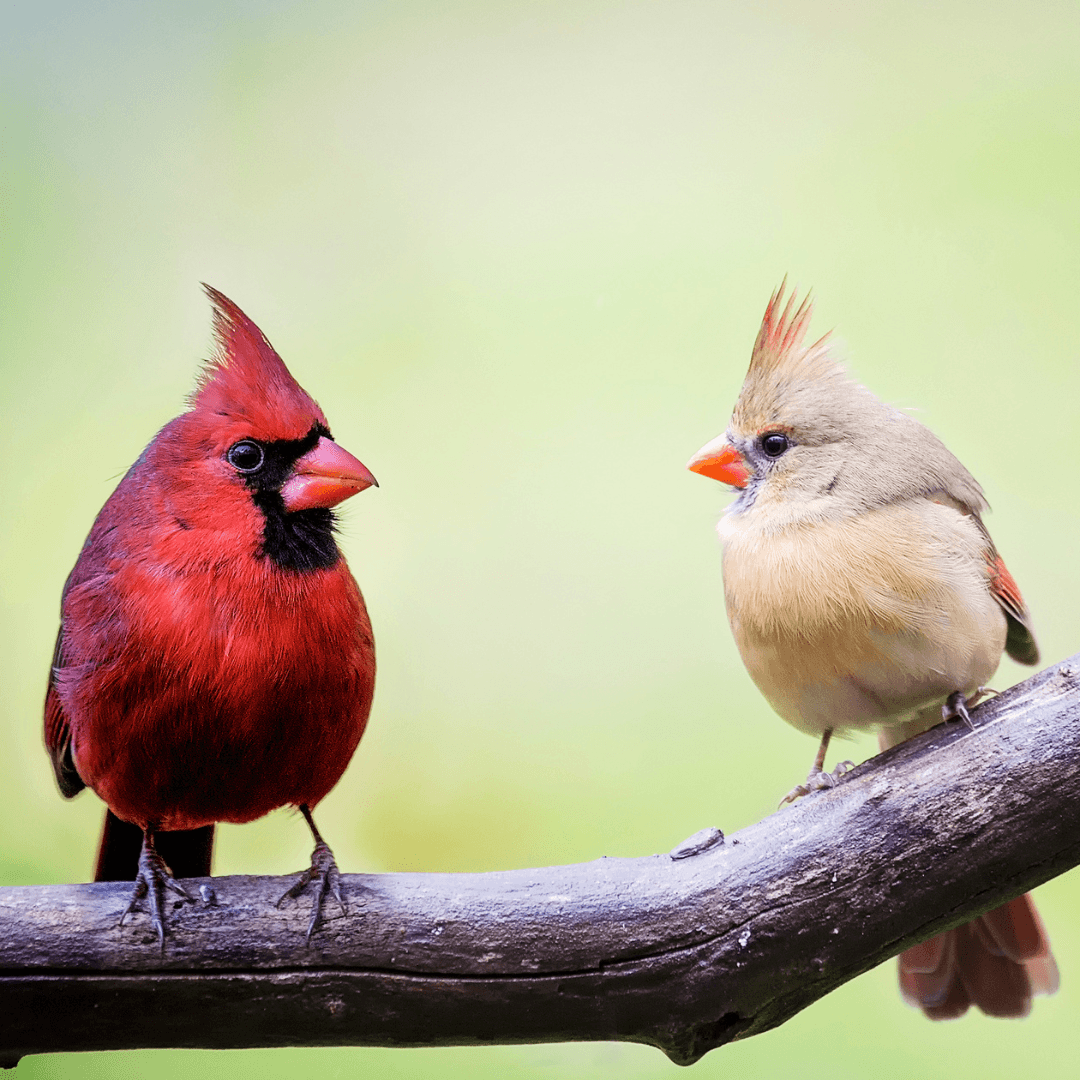
3. Vermilion Cardinal (Cardinalis phoeniceus)
Though primarily found in northern South America, the Vermilion Cardinal is occasionally seen in the southernmost parts of North America.
Males are stunningly bright red, similar to the Northern Cardinal, but with a more vibrant and intense hue.
Females are brownish with red highlights. They inhabit dry, shrubby regions known for their striking appearance and vivid coloration.
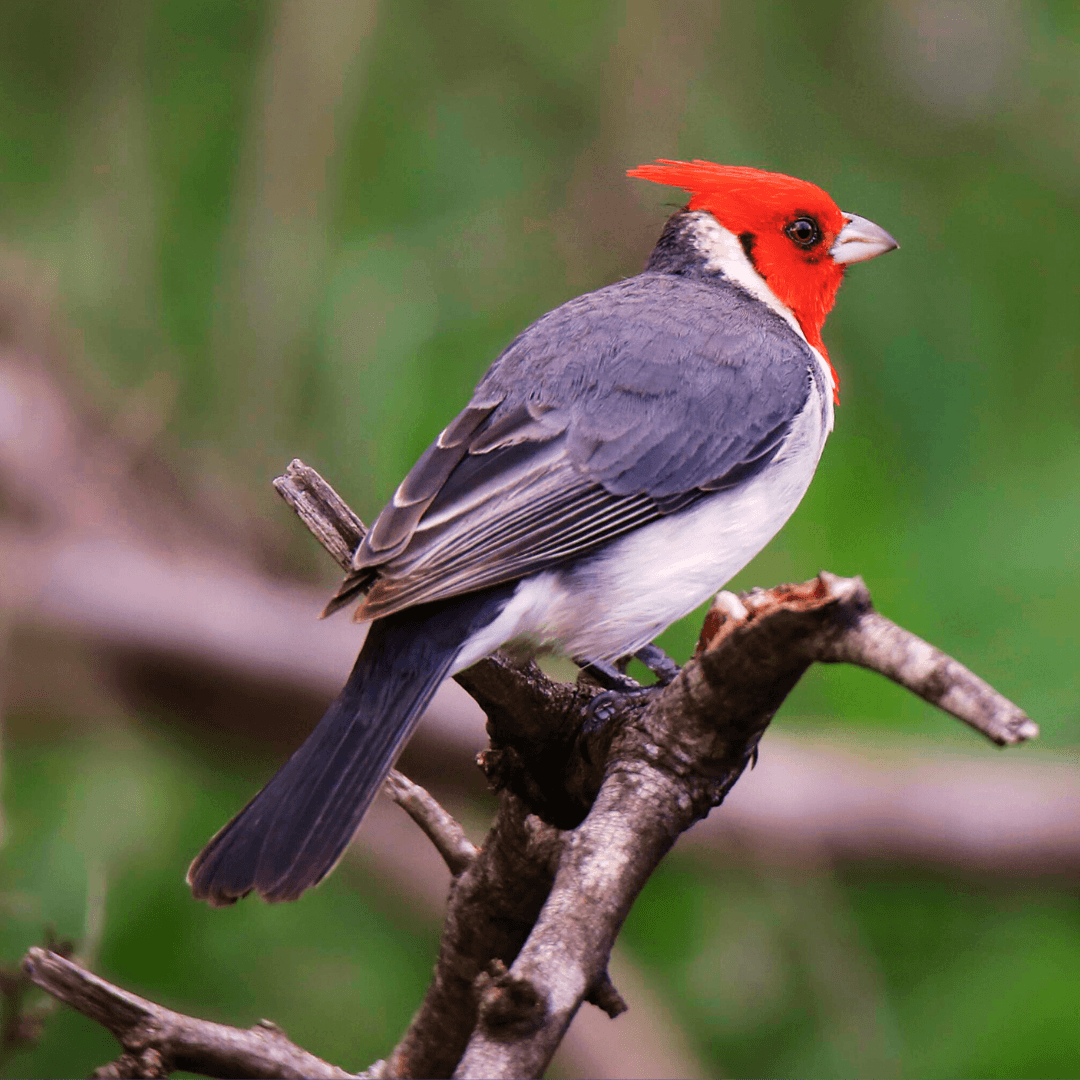
4. Summer Tanager (Piranga rubra)
The Summer Tanager is not a true cardinal. However, it is often mistaken for one due to its bright red plumage. Males are entirely red, while females are mustard yellow.
They are found throughout the southern United States and migrate to Central and South America during the winter. They mostly eat wasps and bees, which they capture in midair.

5. Scarlet Tanager (Piranga olivacea)
The scarlet tanager is another bird often associated with cardinals. Males are striking red with black wings and tails, while females are olive-yellow.
They breed in the eastern United States and migrate to South America for the winter. Their preference for forested habitats makes them a more elusive sight than other cardinal species.
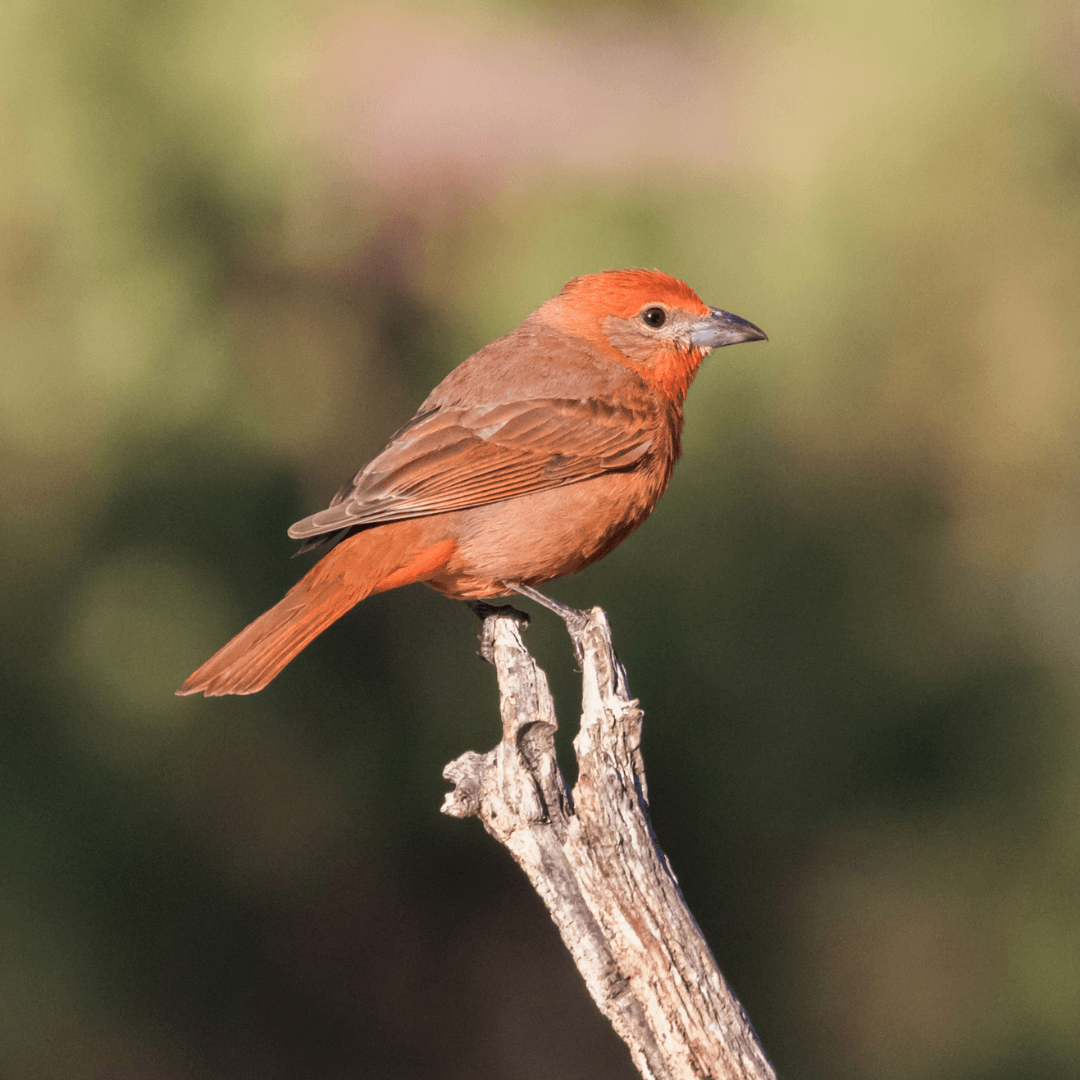
6. Hepatic Tanager (Piranga flava)
The Hepatic Tanager is another member of the cardinal family. It is found in the southwestern United States, Mexico, and Central and South America. Males are distinctive brick red, while females are yellowish with olive tones.
Unlike other tanagers, Hepatic Tanagers have a more muted colour palette, which helps them blend into their forested and wooded habitats.
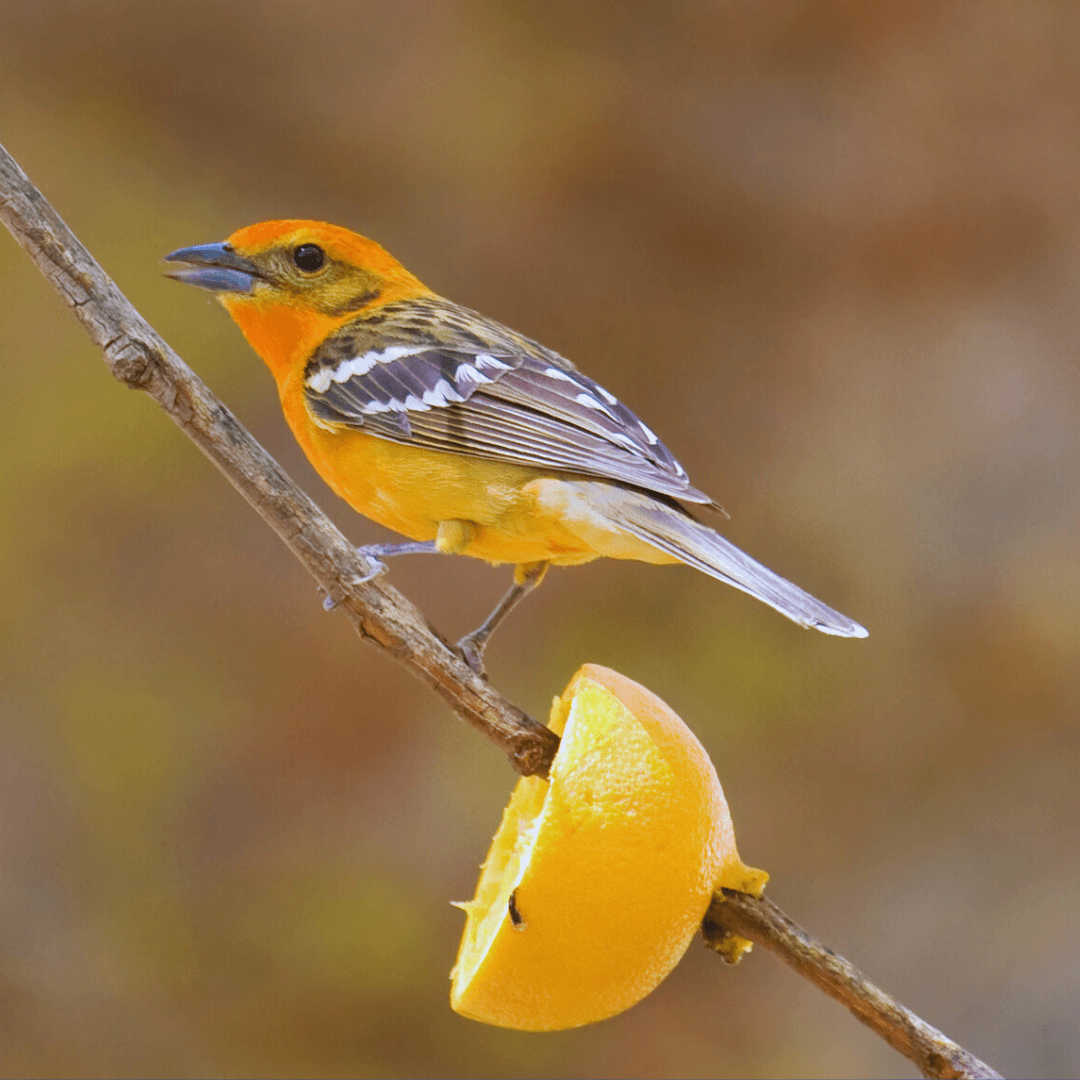
7. Flame-Coloured Tanager (Piranga bidentata)
Native to the mountainous regions of Mexico and Central America, the Flame-coloured Tanager occasionally ventures into the southern United States.
Males are fiery orange-red with black wings, while females are yellowish with olive tones. These striking birds prefer highland forests and often flit through the canopy for insects and fruits.

8. Crimson-Collared Grosbeak (Rhodothraupis celaeno)
Though primarily found in northeastern Mexico, the Crimson-collared Grosbeak can sometimes be spotted in southern Texas.
Males are jet black with a brilliant crimson collar and underparts, while females are olive green with a less pronounced collar.
They live in thick forests and are distinguished by their strong beaks, which they utilize to smash open seeds.
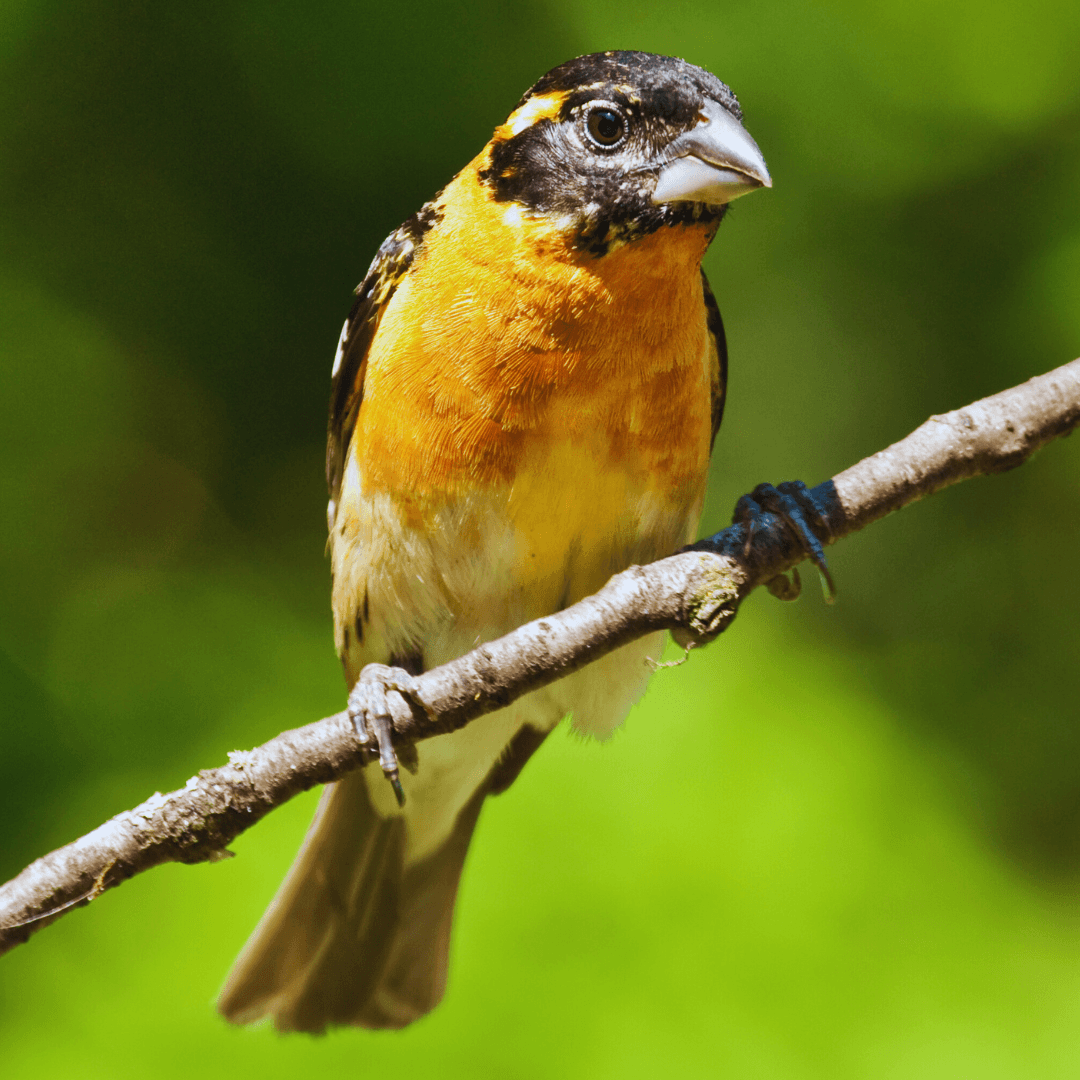
9. Black-Headed Grosbeak (Pheucticus melanocephalus)
The Black-Headed Grosbeak is often confused with cardinals due to its vibrant coloration. It is found in the western United States and migrates to Mexico for the winter.
Males have a striking combination of orange, black, and white, while females are brownish with streaks. They prefer open woodlands and are often seen at feeders during migration.
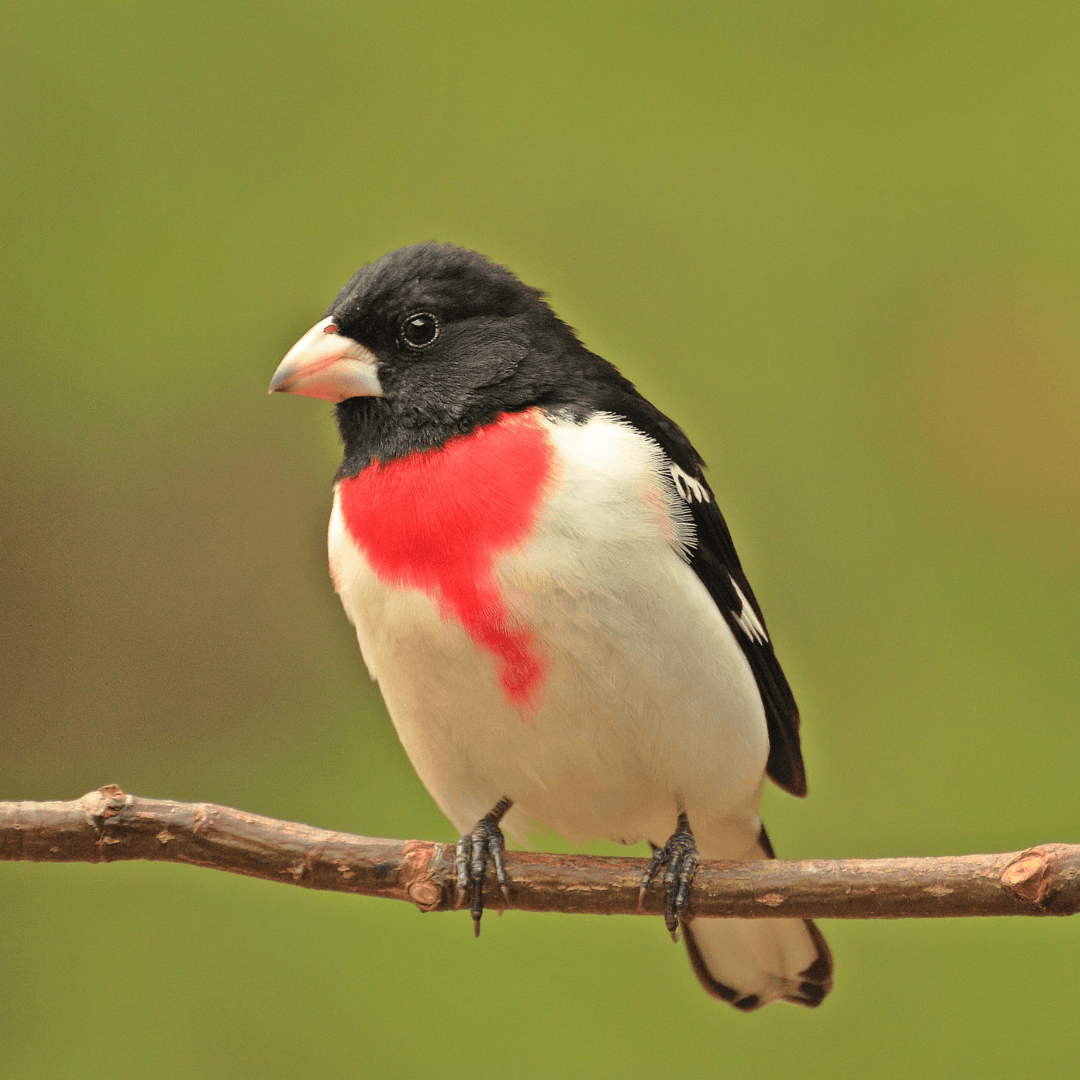
10. Rose-Breasted Grosbeak (Pheucticus ludovicianus)
The Rose-breasted Grosbeak, with its striking coloration, breeds in the northeastern United States and Canada and winters in Central and South America.
Males have a distinctive black and white plumage with a bright red chest, while females are brown and heavily streaked. They frequent forest edges and gardens, feeding on seeds, fruits, and insects.

11. Blue Grosbeak (Passerina caerulea)
Although not a true cardinal, the Blue Grosbeak shares some similarities with its red relatives, such as its habitat in the southern United States, Mexico, and Central America.
Males are a deep, vibrant blue with chestnut wing bars, while females are mostly brown. They inhabit open areas with shrubs and are often seen foraging for seeds and insects.

12. Indigo Bunting (Passerina cyanea)
Another bird often mistaken for a cardinal due to its vibrant colour is the Indigo Bunting. It is found across the eastern United States and migrates to Central and South America for the winter.
Males are a brilliant blue, while females are brown with subtle blue tinges. These birds prefer open woodlands and fields and are known for their cheerful songs.
These diverse species, from the vividly coloured tanagers to the robust grosbeaks, enrich North America's avian landscape.
Each cardinal type brings its unique beauty and ecological role, making it a joy for bird enthusiasts and nature lovers to observe and study.
What Are The Characteristics Of The Northern Cardinal?
The Northern Cardinal (Cardinalis cardinalis) is a striking and beloved songbird with several distinctive characteristics that make it easily recognizable and admired.
Here are some of the key features:
1. Colouration Of The Northern Cardinal
The Northern Cardinal exhibits striking sexual dimorphism in its coloration, with males and females displaying distinct plumage.
Males are adorned in vibrant hues of bright red, commanding attention with their vivid appearance.
This striking colour extends over their entire body, accentuated by a contrasting black mask encircling their eyes and beak, adding an air of boldness to their already eye-catching presence.
In contrast, females boast a more subdued palette, primarily adorned in warm shades of brown.
However, subtle hints of reddish tinges grace their crest, wings, and tail feathers, lending an elegant touch to their appearance.
Like their male counterparts, females also sport a blackish face mask, albeit less pronounced. This variation in coloration between the sexes serves aesthetic purposes and aids in camouflage and thermoregulation, allowing each gender to thrive in their respective roles within the species.
2. Size And Shape Of The Northern Cardinal
The Northern Cardinal possesses a robust yet graceful physique with specific measurements and distinctive features.
With a body length ranging from 8.3 to 9.1 inches (21-23 cm), it falls within the medium-sized category of songbirds.
Its wingspan, spanning approximately 9.8 to 12.2 inches (25-31 cm), provides ample agility for maneuvering through dense vegetation and swift flight.
Despite its relatively small stature, the Northern Cardinal packs a punch in terms of weight, typically between 1.5 and 1.7 ounces (42-48 grams), contributing to its sturdy build.
Its shape is notably adorned with a prominent crest atop the head, adding elegance and distinction.
Additionally, the bird's thick, conical beak is well-adapted for seed-eating, facilitating efficient foraging and easy cracking of open seeds.
These physical attributes collectively contribute to the Northern Cardinal's resilience and adaptability in various habitats, making it a quintessential and cherished member of North America's avian community.
3. Behaviour Of The Northern Cardinal
The Northern Cardinal is renowned for its rich, melodious songs and diverse repertoire of calls, which play crucial roles in communication within the species.
Unlike many North American songbirds, where only males sing, males and females vocalize. These songs and calls serve various purposes, from defending territory to attracting mates and maintaining social bonds within pairs.
During the breeding season, males exhibit heightened territorial behaviour, fiercely defending their territory against intruders through aggressive displays and vocalizations.
Courtship rituals are characterized by elaborate behaviours, including courtship feeding, in which males offer food to females to bond and attract mates.
Additionally, courtship displays involve singing, feather fluffing, and hopping, showcasing the male's vigour and fitness to potential mates.
These courtship behaviours strengthen pair bonds and contribute to successful breeding and the continuation of the species lineage.
4. Feeding And Diet Of The Northern Cardinal
The northern cardinal's diet primarily consists of seeds, grains, and fruits, making it a frequent visitor to backyard bird feeders. It is particularly fond of sunflower seeds.
Insects are added to their diet during breeding season so they may feed both themselves and their nestlings protein.
Their feeding behaviour is characterized by foraging on the ground or in low shrubs and trees. They use their strong, conical beaks to crack open seeds and extract the nutritious kernels inside.
This adeptness at seed-cracking enables them to access various seeds, including those with hard shells.
Cardinals are known for their efficient feeding techniques. They are often seen hopping about or using their feet to stabilize seeds while they crack them open.
Their ability to adapt to various feeding environments and their preference for bird feeders make them a welcome and familiar sight for bird enthusiasts across North America.
5. Reproduction
The Northern Cardinal's reproductive cycle follows a seasonal pattern, with the breeding season typically spanning from March to September.
During this time, females are responsible for constructing cup-shaped nests and meticulously weaving twigs, leaves, and grasses within dense shrubs or small trees to provide a secure environment for their offspring.
Once the nest is complete, females lay clutches of 2-5 eggs, which they incubate for 11-13 days. Throughout the incubation period, females diligently tend to their eggs, maintaining optimal conditions for embryonic development.
Following hatching, feeding and tending to the nestlings is a shared duty between the parents, who regurgitate food to keep their hungry young alive.
The chicks grow quickly under the watchful eyes of their concerned parents. Their collective effort ensures their survival and progress.
Approximately 9-11 days after hatching, the fledglings venture out of the nest, embarking on their journey to independence as they explore their surroundings and hone their flying skills under the guidance of their devoted parents.
6. Lifespan And Predators Of The Northern Cardinal
In the wild, the northern cardinal typically has an average lifespan of up to 3 years. However, some individuals have been known to live significantly longer, with reported lifespans of up to 15 years.
Despite their resilience, northern cardinals face various predators and threats. Birds of prey, such as hawks and owls, pose a significant danger to adult cardinals and their nestlings, hunting them as potential prey. Additionally, snakes are adept at raiding nests to consume eggs or young chicks.
Often allowed to roam freely outdoors, domestic cats present another significant threat to cardinals. They are skilled hunters capable of catching birds in their vicinity.
Furthermore, nest predators like squirrels and jays may raid cardinal nests to feed on eggs or nestlings, posing a constant threat to reproductive success.
Despite these challenges, Northern Cardinals have developed various strategies for survival, including vigilant nest defence and strategic habitat selection to minimize predation risk.
Fun Facts About The Northern Cardinal
The northern cardinal is a beloved bird by nature lovers and birdwatchers due to its bright red coloration and beautiful singing.
Beyond its spectacular look, its amazing qualities are hidden beneath a complex assortment of traits and behaviours. The following are interesting facts regarding the Northern Cardinal:
1. State Bird
The Northern Cardinal is the distinguished state bird of seven states in the United States (Illinois, Indiana, Kentucky, North Carolina, Ohio, Virginia, and West Virginia).
Renowned for its stunning red plumage and enchanting songs, the cardinal serves as a cherished symbol of these regions, embodying their natural beauty and rich biodiversity.
Its vibrant presence in woodlands, parks, and backyards throughout the year has cemented its status as a beloved icon of local flora and fauna.
Whether glimpsed, flitting through dense foliage, or heard singing from treetops, the Northern
Cardinal evokes a sense of pride and connection among residents, symbolizing vitality, hope, and the enduring spirit of the land.
2. Year-Round Residents
Northern Cardinals are steadfast year-round residents in their breeding territories, unlike migratory birds undertaking seasonally long journeys.
This special quality distinguishes them from many other bird species, guaranteeing their continuous presence throughout most of North America's backyards, parks, and woodlands—even in the winter.
Their non-migratory behaviour makes them a familiar and comforting sight for birdwatchers and nature enthusiasts, who can rely on their cheerful presence throughout the year.
Despite facing challenges such as cold temperatures and food scarcity in winter, Northern Cardinals have adapted well to their environments and continue to thrive in urban and suburban landscapes.
Their resilience and ability to endure harsh conditions further solidify their status as beloved icons of local wildlife, bringing joy to countless observers with their vibrant plumage and melodic songs every season.
3. Male Singers
Male Northern Cardinals are renowned for their impressive vocal abilities, as they are the primary singers within the species.
Their songs are characterized by their richness, complexity, and melodiousness, serving multiple purposes in their lives.
Males use singing to mark their territory, ward off intruding males, and announce their presence during the breeding season.
Additionally, their songs play a crucial role in attracting mates, with females often being drawn to males with the most elaborate and captivating songs.
The male's ability to fill the air with cheerful tunes not only advertises his fitness and vitality but also enhances the overall ambiance of their shared habitat.
Through their musical serenades, male Northern Cardinals contribute to the vibrant chorus of sounds in woodlands, parks, and gardens, adding a touch of enchantment to the natural world around them.
4. Monogamous Pairs
Northern Cardinals exemplify monogamous behaviour, forging strong and enduring pair bonds with their mates.
Once a pair forms, they typically remain together year-round, displaying remarkable fidelity. Both members of the pair actively participate in various aspects of reproduction, including nest-building, egg incubation, and feeding the young.
Their cooperative efforts extend beyond the breeding season. They collaborate in defending their territory and foraging for food.
This shared commitment and teamwork contribute to the success and stability of their relationship, allowing them to effectively raise multiple broods of offspring over successive breeding seasons.
Through their mutual dedication and cooperation, monogamous pairs of Northern Cardinals exemplify the importance of partnership and collaboration in the journey of life and reproduction.
5. Urban Dwellers
Northern Cardinals exhibit remarkable adaptability, seamlessly integrating into diverse habitats ranging from pristine woodlands to bustling urban environments.
Their versatility allows them to flourish in gardens, parks, and even city neighbourhoods, earning them the endearing moniker of “backyard bird.”
Despite human activity and alterations to their natural habitats, Northern Cardinals have adeptly navigated these changes, capitalizing on the abundance of food sources and nesting opportunities provided by urban landscapes.
Their ability to coexist with humans has made them a familiar and cherished sight for city dwellers, who often delight in observing these charismatic birds frequenting their feeders or perching on tree branches.
By thriving in urban settings, Northern Cardinals demonstrate their resilience and capacity to adapt to ever-changing environments, symbolizing nature's ability to persist and thrive alongside human development.
Conclusion
In conclusion, the Northern Cardinal symbolizes beauty, resilience, and adaptability in the avian world.
Its vibrant red plumage, melodic songs, and charismatic presence make it a beloved icon across North America.
Whether it's seen dancing through forests, picking food in gardens, or singing from the tops of trees, the Northern Cardinal never ceases to enthrall with its grace and charisma.
It reminds us of the continuing relationship between people and the natural environment and is a beloved emblem of life and hope that awes and inspires everyone who sees it.
I trust you enjoyed this Fun Facts About The Northern Cardinal article. Please stay tuned for more blog posts soon. Take care!
JeannetteZ
Your Opinion Is Important To Me
Do you have thoughts, ideas, or questions? I would love to hear from you. Please leave me your questions, experiences, and remarks about this article, Fun Facts About The Northern Cardinal, in the comments section below. You can also email me at Jeannette@Close-To-Nature.org.
Disclosure
This post may contain affiliate links. As an Amazon Associate and other affiliate programs, I earn from qualifying purchases at no extra cost to you. Please read my full affiliate disclosure.
You might also enjoy these blog posts:
Interesting Facts About Mourning Doves
Symptoms Of Omega-3 Deficiency
Best Soil For Growing Vegetables
Best Ways To Prepare Soil For Fruit Trees
Best Soil To Use For Flowering Plants

